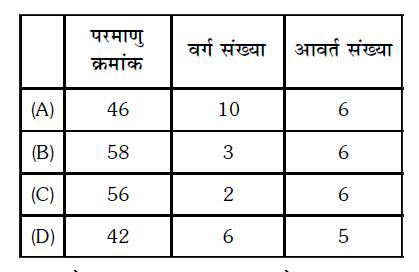ऑक्साइड आयन O2−(g) का ऑक्सीजन परमाणु से बनने के लिये पहले ऊष्माक्षेपी एवं बाद में ऊष्माशोषी पद नीचे दिये गये हैं: -
O(g)+e−→O−(g),ΔfHө=−141kJ mol−1
O−(g)+e−→O2−(g),ΔfHө=+780kJ mol−1
गैसीय O2− का बनना प्रतिकूल है यद्यपि O2− निऑन का समइलेक्ट्रॉनी है। यह किस तथ्य के कारण है?
ऑक्सीजन ज्यादा वैद्युत ऋणात्मक है।
ऑक्सीजन में इलेक्ट्रॉन के जोड़ से आयन का आकार बड़ा होता है।
नोबल गैस के विन्यास प्राप्ति के कारण स्थायीत्व से, इलेक्ट्रॉन प्रतिकर्षण प्रभावशाली होता है।
O− आयन का आकार ऑक्सीजन परमाणु तुलना में छोटा होता है।
The correct Answer is:C
Step by step video, text & image solution for ऑक्साइड आयन O^(2-)(g) का ऑक्सीजन परमाणु से बनने के लिये पहले ऊष्माक्षेपी एवं बाद में ऊष्माशोषी पद नीचे दिये गये हैं: - O(g)+e^(-) to O_((g))^(-) , Delta_fH^(ө)=-141 "kJ mol"^(-1) O^(-) (g) +e^(-) to O_((g))^(2-) , Delta_f H^(ө)=+780 "kJ mol"^(-1) गैसीय O^(2-) का बनना प्रतिकूल है यद्यपि O^(2-) निऑन का समइलेक्ट्रॉनी है। यह किस तथ्य के कारण है? by Chemistry experts to help you in doubts & scoring excellent marks in Class 12 exams.
Updated on:21/07/2023Topper's Solved these Questions
- आवर्त सारणी Book:ALLEN HINDIChapter:आवर्त सारणी Exercise:Exercise-III (Analytical Questions)
Explore 38 Videos
- आवर्त सारणी Book:ALLEN HINDIChapter:आवर्त सारणी Exercise:Exercise-IV (Assertion & Reason)
Explore 25 Videos
- आवर्त सारणी Book:ALLEN HINDIChapter:आवर्त सारणी Exercise:Exercise-I (Conceptual Questions)
Explore 131 Videos
- अभिक्रिया क्रियाविधि : भाग-I Book:ALLEN HINDIChapter:अभिक्रिया क्रियाविधि : भाग-I Exercise:EXERCISE -IV (ASSERTION & REASON) (TARGET AIIMS) (AIIMS 2018)
Explore 5 Videos
- उपसहसंयोजन यैगिक Book:ALLEN HINDIChapter:उपसहसंयोजन यैगिक Exercise:Exercise-IV Assertion & Reason
Explore 28 Videos
Similar Questions
निम्न में से कौनसा सही मिलान है :-

View Solutionकथन : आर्गन की क्रमागत आयनन उर्जाएँ क्रमश: 56.8 eV व 36.8 eV हैं।
कारण : Ar(3s23p6) का Zeff Ar+(3s23p5) से अधिक होता है
View Solutionमेण्डलीफ की आवर्त सारणी का आधार है :
View Solutionकथन :-m-नाइट्रोफिनॉल की तुलना में o-नाइट्रोफिनॉल ज्यादा अम्लीय है।
कारण :-o-स्थिति पर, −NO2 , का - प्रभाव m-स्थिति की तुलना में ज्यादा होता है।
View Solutionकथन:K2SO4.Al2(SO4)3.24H2O विलयन अम्लीय प्रकृति का होता है।
कारण : यह आयनित होकर संकुल आयन देता है।
View SolutionThe average O−H Bond energy in H2O with the help of following data :
(P) H2O(l)→H2O(g), ΔH=+40.6kJmol−1
(Q) 2H(g)→H2(g), ΔH=−435.0kJmol−1
(R ) O2(g)→2O(g), ΔH=+489.6kJmol−1
(S) 2H2(g)+O2(g)→2H2O(l), ΔH=−571.6kJmol−1
View SolutionGiven that :
O(g)+e−→O−(g)ΔH=−142kJmol−1
O(g)+2e−→O2−(g)ΔH=+712kJmol−1
what will be the ΔH for the reaction:
O−(g)+e−→O2−(g)
View SolutionCalculate the standard enthalpy change (in kJ mol−1) for the reaction H2(g)+O2(g)→H2O2(g), given that bond enthalpy of H-H, O=O,O-H and O-O (in kJ mol−1) are respectively 438, 498, 464 and 138.
View SolutionThe formation of the oxide ion O2−(g), from oxygen atom requires first an exothermic and then an endothermic step as shown below :
O(g)+e^(-) to O(g): Delta_(f)H^(Ѳ)= - 141 "kJ mol"^(-1)
O−(g)+e−→O2−(g),ΔfHѲ=+780kJ mol−1
Thus process of formation of O2− in gas phase in unfavourable even though O2− is isoelectronic with neon. It is due to the fact that
View SolutionThe formation of the oxide ion O^(2-) (g) requires first an exothermic and then an endothermic step as shown below : O (g) + e^(-) to O^(-) ( g) : Delta H^(@) =- 142 k J mol^(-1) O^(-) (g) + e^(-) to O^(2-) (g) , DeltaH^(@) = + 844 kJ mol^(-1) This is because
View SolutionThe formation of oxide ion O2−(g) from oxygen atom requires first an exothermic and then an endothermic step as shown below
O(g)+e−→O−(g),ΔH−=−141kjmol−1
O−(g)+e−→O2−(g),ΔH−=+780kjmol−1
Thus, process of formation of O2− in gas phase is unfavourable even through O2− is isoelectronic with neon. It is due to the fact that A) oxygen is more electronegative B) addition of electron in oxygen results in larget size of the ion C) electron repulsion outweights the stability gained by achieving noble gas configuration D) O− ion has comparatively smaller size than oxygen atom
View SolutionAt 25∘C, the standard heats of formation of H2O(g),H2Og,H(g)andO(g) are -241.8, -135.66, 218 and 248.17kJ⋅mol−1 respectively. The bond energy (in kJ⋅mol−1) of O-O bond in H2O2(g) molecule is-
View SolutionCalculate the bond strength of O-H bond in O−H bond in H2O(g) from the following data :
H2(g)→2H(g),ΔH0=436kJ⋅mol−1
12O2(g)→O(g),ΔH0=249kJ⋅mol−1
H2(g)+12O2(g)→H2O(g),ΔH0=−241kJ⋅mol−1
View SolutionCalculate the standard enthalpy change (in kJ mol−1) for the reaction H2(g)+O2(g)→H2O2(g), given that bond enthalpy of H-H, O=O,O-H and O-O (in kJ mol−1) are respectively 438, 498, 464 and 138.
View SolutionCalculate Delta_(r)H^(@) for the reaction, H_(2)(g) + 1/2O_(2)(g) to H_(2)O(g) Given that bond enthalpies of H-H bond , O = O bond and O - H bond are 433 kJ mol^(-1) , 492 kJ "mol"^(-1) and 464 kJ "mol"^(-1)
View Solution